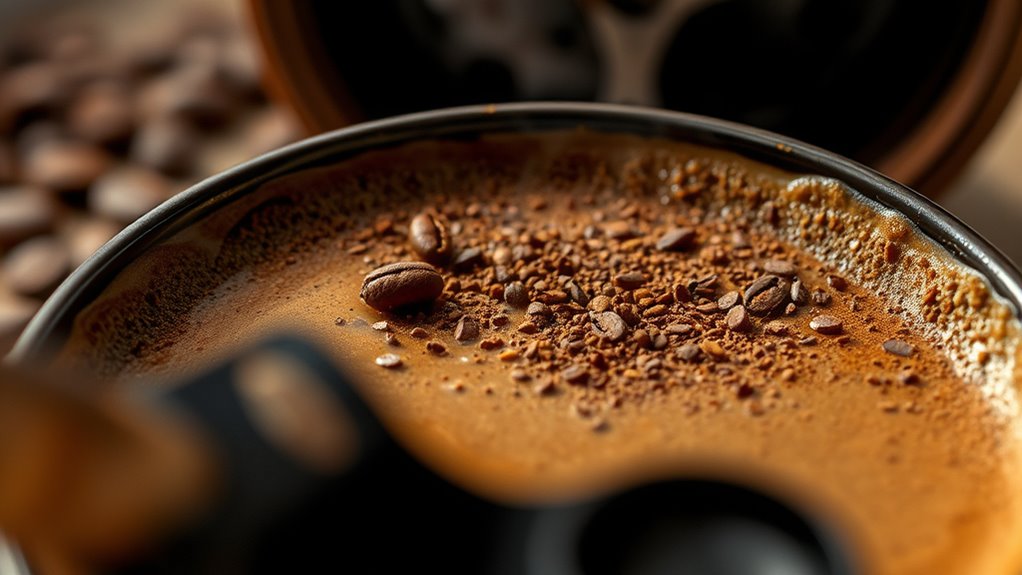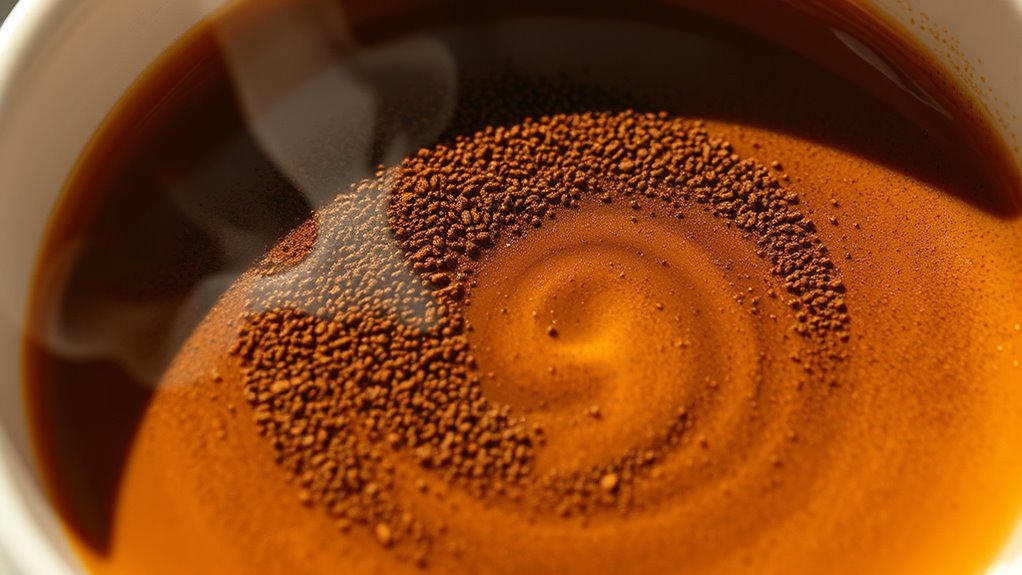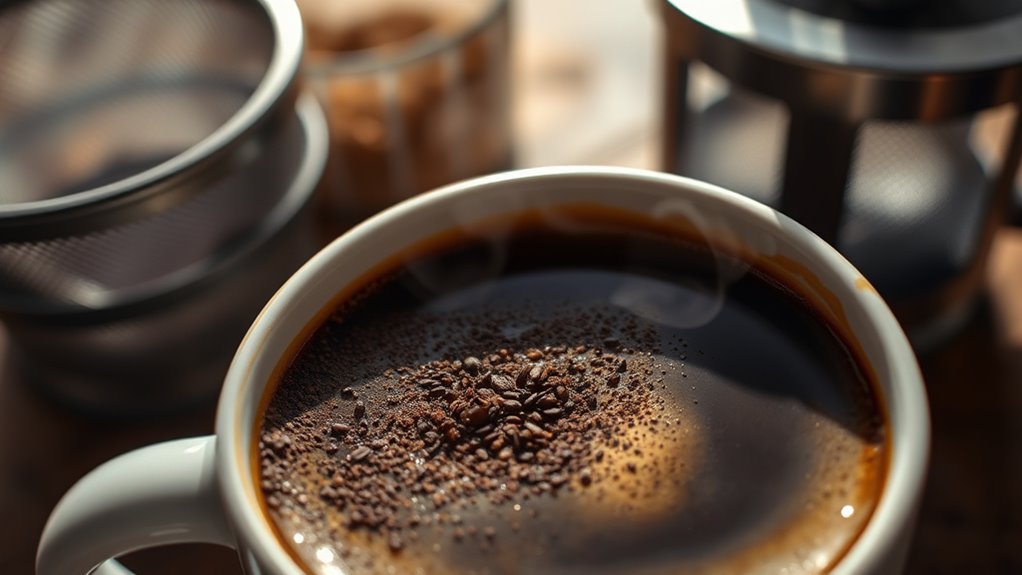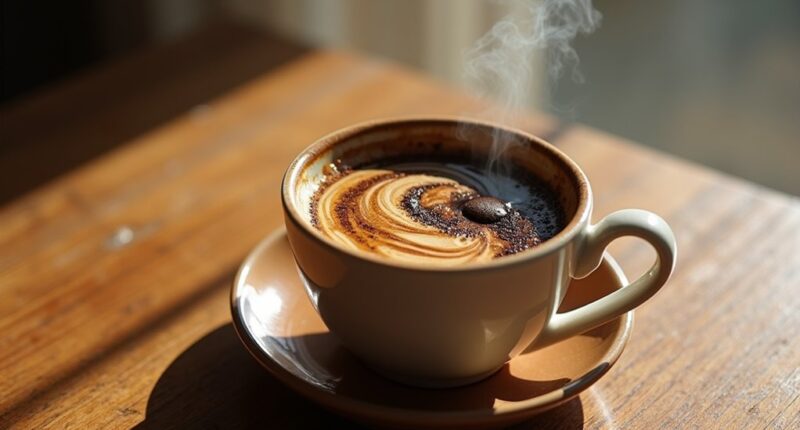Ever wonder why there are coffee grounds sneaking around in your cup? It’s likely due to the grind size and how you brew it. If you’re using a French press with too-fine grounds, or not filtering properly, those pesky bits can float around. Plus, some methods, like espresso or pour over, keep things cleaner than others. It’s all about finding that perfect balance. Stick around, and you’ll pick up some nifty tips to banish those grounds for good!
At a Glance
- Coffee grounds can appear due to improper grind size; finer grounds may escape filters, especially in methods like French press or espresso.
- Over-extraction during brewing can lead to more fines, creating a gritty texture in your coffee.
- Using a metal filter allows more micro-grounds and oils to pass through compared to paper filters.
- Overfilling filters can cause overflow, leading to grounds mixing into the brewed coffee.
- Brewing methods like French press naturally retain some sediment due to their immersion style and coarse grind requirements.
Understanding Coffee Grounds: Causes and Characteristics

When you sip your morning coffee and spot those pesky grounds floating around, it can feel like a mini disaster in your cup. But don’t worry! Those grounds come from roasted beans, ground into various sizes.
The grounds composition includes oils and cellulose, which impact extraction efficiency. If your grind’s too fine or your filter isn’t up to snuff, those little guys can sneak in.
Grounds are made of oils and cellulose that affect your brew—watch your grind size and filter for a smoother sip!
Coarser grounds settle faster, but finer ones might just hang out, determined to ruin your sip. Using the right grind size is essential for achieving the perfect brew, especially when using a French press coffee grinder. So, next time you see them, remember—it’s just part of the coffee adventure, not a catastrophe!
Enjoy the ride!
The Impact of Brewing Methods on Grounds Presence
Brewing coffee can feel like a bit of a science experiment, especially when it comes to those pesky grounds that can sneak into your cup. Different brewing methods affect how many of those little guys make it into your drink.
| Brewing Method | Grounds Presence |
|---|---|
| Pour Over | High clarity, no grounds |
| French Press | Full texture, some grit |
| Espresso | Rich crema, few fine grounds |
| Cold Brew | Smooth, minimal sediment |
To minimize grounds in your cup, it’s essential to use the recommended coarse grind size for French press brewing, as it prevents excessive sediment and allows for optimal flavor extraction.
The Role of Grinding Techniques and Particle Size

Have you ever wondered why your coffee sometimes tastes a bit off? It might be all about the grind! The size of your coffee particles plays a huge role in flavor.
If your grind consistency isn’t right, you could end up with over-extracted bitterness or sour notes. Each brewing method needs its perfect grind—like coarse for French press or fine for espresso.
Plus, different grinders can create variations that impact extraction balance. So, next time you sip, think about how the grind affects that delicious cup. A little tweak might just turn your average brew into something extraordinary! Additionally, understanding grind consistency can help you achieve the desired taste and aroma in your coffee.
Brewing Parameters That Influence Grounds in Coffee
If you’ve ever found yourself wondering why your coffee’s got more sediment than a muddy river, you’re not alone!
It all comes down to brewing ratios and brew times. Using a high coffee-to-water ratio can leave you with a denser brew, which means more fine grounds floating around.
And let’s not forget brew times—if you steep too long, especially with immersion methods, those pesky fines will show up. Additionally, the rich flavors of ground coffee can be affected by the grind size, which plays a crucial role in the extraction process.
Play with your ratios and times to find that sweet spot. A scale can help you nail those measurements, and soon, you’ll be enjoying a cleaner cup of joe with less grit!
Filtering Techniques and Their Effect on Grounds

When you’re pouring your morning cup of coffee, the last thing you want is to be greeted by a surprise sludge at the bottom of your mug.
Choosing the right filter types and filter design can make all the difference! Paper filters are champs at catching those pesky fines, leaving you with a clean, sludge-free cup.
On the flip side, metal filters let more oils and micro-grounds slip through—hello, sediment!
Plus, the shape matters. Cone-shaped filters slow water flow for a richer brew, but if you overfill, you risk a messy overflow. A coarse grind is essential for French press coffee, as it prevents bitterness and enhances the overall brewing experience.





